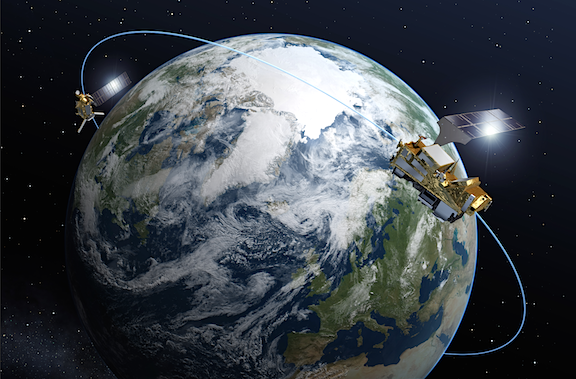[SatNews] RUAG Space will supply meteorological instruments and structures for the second generation of Europe’s Metop weather satellites. At the Paris Air Show, representatives from prime contractor Airbus Defence and Space and RUAG Space signed contracts for these supplies with a total value of roughly 60 million Euro.
Metop satellites are the other pillar of Europe’s weather satellite network next to the Meteosats. Whereas Meteosats observe the weather on a large scale seeing one third of the Earth from their geostationary vantage point some 36,000 kilometers above the Earth, Metop satellites orbit our planet at a height of around just 800 kilometers. This allows them to study relatively small areas of the Earth’s atmosphere with a great deal of precision, and see the whole world every five days. Particularly in the medium to long term, the data they gather allows us to forecast the weather far more accurately than would be possible with geostationary satellites alone.

Europe’s Metop weather satellites
There will be a total of six Metop-SG (Meteorological Operational Satellite – Second Generation) satellites, the first two of which are scheduled to replace the last first-generation Metop satellite by the end of the decade. Each satellite has to be replaced about every eight years. This means that the second-generation Metop satellites will be providing Europe with weather data past the year 2040.
RUAG Space in Gothenburg, Sweden, has been selected to supply the second generation GRAS-2 meteorological instrument as the RO (Radio Occultation) instrument on all MetOp satellites. The RO Instrument uses radio signals from global satellite navigation systems to characterize the atmosphere in terms of temperature, pressure, humidity and electron content. RO data has become essential for operational weather forecasting, climate monitoring and space weather applications.
Similar to the self-supporting chassis of a car, the structures form the “backbone” of the satellites, onto and into which are mounted all the satellites’ other components. RUAG Space in Zurich will not only design and manufacture the satellite structures, but will also pre-integrate a range of other assemblies. These include, as an example, electrical harnesses and the system that controls the satellites’ interior temperature.